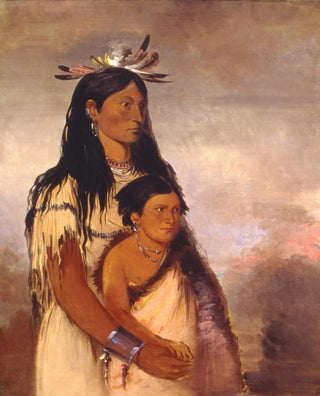Art print | Tnkahthye Thunderer, a boy, and Wunpntomee White Weasel, a girl - George Catlin


View from behind

Frame (optional)
In the fascinating world of 19th-century American art, the art print "Tnkahthye Thunderer, a boy, and Wunpntomee White Weasel, a girl" by George Catlin stands out for its narrative depth and authentic depiction of Native American cultures. This painting, emblematic of Catlin's quest to immortalize the traditions and lifestyles of the tribes he encountered, transports us to a world where harmony between man and nature is palpable. Through this work, the artist does not merely capture faces but evokes stories, rites, and emotions, inviting us to delve into the very soul of the characters he depicts.
Style and uniqueness of the work
George Catlin's style is characterized by meticulous attention to detail and a vibrant color palette that breathes life into his subjects. In "Tnkahthye Thunderer, a boy, and Wunpntomee White Weasel, a girl," the characters are presented in a dynamic posture, illustrating not only their individuality but also their connection to their environment. The clothing patterns, richly adorned, testify to the cultural heritage of the Sioux, while the background, often sparse, highlights the strength and resilience of the human figures. Catlin employs pictorial techniques that combine realism and romanticism, creating an atmosphere that is both documentary and poetic. This art print, through its composition and use of colors, invites reflection on identity and memory, paying homage to a culture on the verge of disappearance.
The artist and his influence
George Catlin, born in 1796, is often regarded as one of the first artists to dedicate his career to the representation of Indigenous peoples of America. Traveling across the continent, he captured the essence of the tribes he encountered, becoming a true visual chronicler of their existence. His commitment goes beyond mere artistic representation; it is a mission of preservation, a desire to document a way of life threatened by colonial expansion. Catlin also played a crucial role in raising public awareness

Matte finish

View from behind

Frame (optional)
In the fascinating world of 19th-century American art, the art print "Tnkahthye Thunderer, a boy, and Wunpntomee White Weasel, a girl" by George Catlin stands out for its narrative depth and authentic depiction of Native American cultures. This painting, emblematic of Catlin's quest to immortalize the traditions and lifestyles of the tribes he encountered, transports us to a world where harmony between man and nature is palpable. Through this work, the artist does not merely capture faces but evokes stories, rites, and emotions, inviting us to delve into the very soul of the characters he depicts.
Style and uniqueness of the work
George Catlin's style is characterized by meticulous attention to detail and a vibrant color palette that breathes life into his subjects. In "Tnkahthye Thunderer, a boy, and Wunpntomee White Weasel, a girl," the characters are presented in a dynamic posture, illustrating not only their individuality but also their connection to their environment. The clothing patterns, richly adorned, testify to the cultural heritage of the Sioux, while the background, often sparse, highlights the strength and resilience of the human figures. Catlin employs pictorial techniques that combine realism and romanticism, creating an atmosphere that is both documentary and poetic. This art print, through its composition and use of colors, invites reflection on identity and memory, paying homage to a culture on the verge of disappearance.
The artist and his influence
George Catlin, born in 1796, is often regarded as one of the first artists to dedicate his career to the representation of Indigenous peoples of America. Traveling across the continent, he captured the essence of the tribes he encountered, becoming a true visual chronicler of their existence. His commitment goes beyond mere artistic representation; it is a mission of preservation, a desire to document a way of life threatened by colonial expansion. Catlin also played a crucial role in raising public awareness






